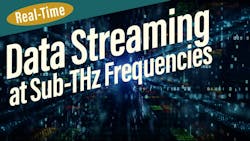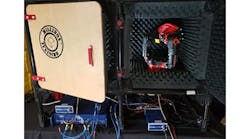Vector Signal Transceiver Forms Core of Sub-THz Test Architecture
>>Check out this TechXchange for similar articles and videos
Test and measurement in the sub-THz frequency realm is a critical aspect of building toward upcoming generations of 5G/6G, Wi-Fi, Bluetooth, and other wireless technologies. Test gear must be more accurate even as validation test strategies for RF front ends and transceivers become more challenging.
To that end, Emerson’s NI unit developed a series of PXI Vector Signal Transceivers (VSTs), the latest of which, the PXIe-5842, offers a 54-GHz frequency extension. It has the coverage to span frequencies dedicated to WLAN, UWB, 5G FR1, and all 5G FR2 frequencies (24.25 to 52.6 GHz).
As a result, the PXIe-5842 suits many aerospace and defense applications from UHF into the V-band, including radar target simulation, spectrum monitoring, or parametric test of electronically scanned array components used in radar and satellite communications.
In the video that accompanies this article, NI Fellow Marcus DaSilva demonstrates an application of Emerson NI’s sub-THz reference architecture. He shows how the VST can generate real-time modulation/demodulation at frequencies up to 170 GHz.
Using random bits with no error correction, the VST transmits a 16-QAM signal with a 156-GHz carrier. Symbols are generated using direct modulation and with an error vector magnitude of about 34 dB. System throughput as demonstrated is 8.6 Gb/s over a link with 4 GHz of bandwidth.
Related Content
About the Author
David Maliniak
Executive Editor, Microwaves & RF
I am Executive Editor of Microwaves & RF, an all-digital publication that broadly covers all aspects of wireless communications. More particularly, we're keeping a close eye on technologies in the consumer-oriented 5G, 6G, IoT, M2M, and V2X markets, in which much of the wireless market's growth will occur in this decade and beyond. I work with a great team of editors to provide engineers, developers, and technical managers with interesting and useful articles and videos on a regular basis. Check out our free newsletters to see the latest content.
You can send press releases for new products for possible coverage on the website. I am also interested in receiving contributed articles for publishing on our website. Use our contributor's packet, in which you'll find an article template and lots more useful information on how to properly prepare content for us, and send to me along with a signed release form.
About me:
In his long career in the B2B electronics-industry media, David Maliniak has held editorial roles as both generalist and specialist. As Components Editor and, later, as Editor in Chief of EE Product News, David gained breadth of experience in covering the industry at large. In serving as EDA/Test and Measurement Technology Editor at Electronic Design, he developed deep insight into those complex areas of technology. Most recently, David worked in technical marketing communications at Teledyne LeCroy, leaving to rejoin the EOEM B2B publishing world in January 2020. David earned a B.A. in journalism at New York University.





